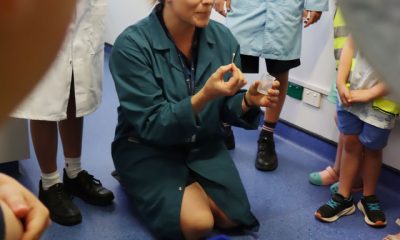Science
NASA is updating its guidelines on how to prevent contamination of the Solar System – The Verge
NASA plans to update its guidelines for how much biological contamination of the Moon and Mars will be allowed, as the agency plans to send humans into deep space in the years and decades to come.

The rules for exploring the Moon and Mars are getting some changes
An artistic rendering of astronauts landing on the surface of the Moon again
Image: NASA
After years of debate, NASA plans to update its guidelines for how much biological contamination of other worlds will be allowed while the agency explores the Solar System. The new rules would relax some of the agencys requirements for how to explore the Moon and Mars two high-profile destinations where NASA hopes to send astronauts in the coming years.
For decades, NASA has followed fairly strict rules about how much biological contamination is considered acceptable whenever the agency sends probes or people to other planets. Its a concept known as planetary protection, and it has a legal basis in a treaty signed more than 50 years ago. Called the Outer Space Treaty, it challenges nations to explore other worlds so as to avoid their harmful contamination and to not bring back any alien microbes from other worlds that could cause harm to Earth.
A big goal of planetary protection has been to keep us from tracking microbes all over the Solar System
A big goal of planetary protection has been to keep us from tracking microbes all over the Solar System. That way, if we were to come across some kind of life form on another world, we would know with certainty that it actually came from that world and that we didnt put it there on accident. Planetary protection is also focused on keeping humans safe, too. If a country does find life, we want to make sure its not going to wipe us out if they bring it back to our planet.
Adhering to planetary protection has always been a bit of a trade-off, since practically everything we send into space has some kind of microbe on it. Depending on where theyre headed in the Solar System, spacecraft often undergo really strict cleaning procedures in an attempt to get rid of these tiny organisms. For some, that means getting baked at high temperatures to kill off microbes and to make the vehicles as immaculate as possible.
But now, NASA is particularly focused on sending humans into deep space once again. And whenever people go into space, we carry tons of bacteria with us, no matter how much we clean. With human exploration such a high priority, NASA now wants to rethink some of the more strict requirements for the Moon and Mars otherwise human exploration would be too tough to pull off. Today, NASA released two new interim directives that lay out potential changes to the guidelines for exploring the Moon and Mars. It follows years of urging from the space community to update these rules.
We need to relook at these policies.
We need to relook at these policies because we cant go to Mars with humans if the principle that were living by is that we cant have any microbial substances with us, NASA administrator Jim Bridenstine said during a webinar announcing the new proposed changes. Because thats just not possible.
The first directive revolves around reclassifying parts of the Moon so that there are less restrictions for sending spacecraft and people there. Under current planetary protection rules, the Moon is considered a Category II celestial body, which means there is a rare chance that contamination carried by a spacecraft could jeopardize future missions. The Moon received this designation after scientists discovered that there was potentially a lot of water ice lurking on the lunar surface. And whenever theres water somewhere in the Solar System, scientists are always cautious about the possibility of it sustaining some kind of life.
The new interim directive would reclassify the Moon as mostly a Category I body, which doesnt require any planetary protection requirements because theres no expectation of finding life. But, NASA would still consider parts of the Moon notably craters where water ice is thought to exist as Category II locations. We need to make sure that when we go to the Moon, were protecting those very important scientific sites where there is a risk of… harmfully contaminating the Moon from a biological perspective, Bridenstine said.
we just have to be really careful to inventory all of the biology that we may be taking with us.
Such places would include the lunar south pole, which is believed to host quite a bit of water ice in its craters that are permanently in shadow. Under Category II, you can go there, but we just have to be really careful to inventory all of the biology that we may be taking with us, said Bridenstine.
The second directive would update the Mars rules so that human missions will be allowed in the future. Right now, Mars is a fairly restricted planet. Its a Category IV body for landers, which means theres a big interest in finding life there and a significant risk of contamination. Meanwhile, parts of the planet where there might be liquid water are even more restricted, requiring more intensive guidelines. NASA is not recommending to change the designations of Mars. But the interim directive does call for the agency to come up with new guidelines, based on what we continue to learn about Mars from upcoming missions like the Perseverance rover launching this summer. The challenge with Mars is that we simply dont yet have enough information to know where it is we can go and where we shouldnt go and where we can go but we need to be more careful than other places, said Bridenstine. He added: We will continue to refine, make adjustments, and then, as much as possible, open it up to where theres more access for more people; I should say, more missions.
These new interim directives are meant to be malleable, according to Bridenstine. These are not policy directives; theyre not set in stone, he said.
These new policies are the latest in a number of changes and new guidelines that NASA is creating as it strives to go back to the Moon through its Artemis program. In May, NASA announced the creation of the Artemis Accords, a set of international standards for exploring the Moon that it hopes other countries will follow. As the community of nations goes forward to the Moon and on to Mars, we need to make sure that the United States of America, through NASA and its policy directives, that we are leading, and thats really what were trying to achieve here, Bridenstine said.

-

 General24 hours ago
General24 hours agoMitchell Starc fires Ashes warning in Sheffield Shield return as Jake Weatherald and Beau Webster fail to fire
-

 General23 hours ago
General23 hours agoGlobal humanitarian Alison Thompson awarded 2026 Australian of the Year for NSW
-

 Business5 hours ago
Business5 hours agoMonash IVF has named a new Managing Director to help right the ship
-

 Noosa News23 hours ago
Noosa News23 hours agoRecognition for outstanding teacher | Noosa Today
